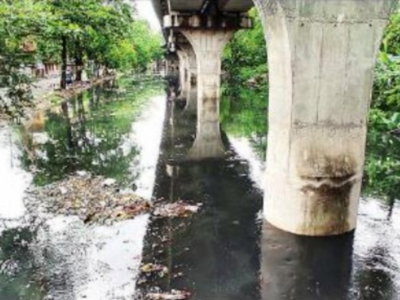Top Searches
- News
- City News
- kolkata News
- West Bengal: ‘Adi Ganga water hazardous for people living nearby’
West Bengal: ‘Adi Ganga water hazardous for people living nearby’

The total coliform count was highest at Bansdroni.
KOLKATA: The pollution level of Adi Ganga’s water is 20 times more than that of Santragachhi Jheel, tests conducted by the West Bengal Pollution Control Board (WBPCB) have revealed.
From dumping of untreated sewage and other pollutants to lack of dredging and blockage in the water flow caused by changes in the hydrodynamics due to Metro columns and construction work of several bridges across it, the filthy brackish water is not only making it impossible to sustain any aquatic life, it is also becoming hazardous to the health of people living along it.
Along the entire stretch, WBPCB tests could not trace any dissolved oxygen, which is an absolute necessity for survival of aquatic life. For propagation of aquatic life, at least 4mg/l of dissolved oxygen is required.
Biological oxygen demand (which should be less than 3mg/l) was almost eight times of the water quality criteria for outdoor bathing. The canal does not even qualify for propagation of wildlife and fisheries that requires dissolved oxygen more than 4mg/l.
The coliform bacteria count of more than 300000 per 100 ml against the criterion value of 500 in the same scale for outdoor bathing. The river is in the condition of septic tank and immediately requires stoppage of inflow of a single further drop of municipal waste water, said Subhas Dutta, who is an amicus curiae of Adi Ganga case in NGT.
From dumping of untreated sewage and other pollutants to lack of dredging and blockage in the water flow caused by changes in the hydrodynamics due to Metro columns and construction work of several bridges across it, the filthy brackish water is not only making it impossible to sustain any aquatic life, it is also becoming hazardous to the health of people living along it.
Along the entire stretch, WBPCB tests could not trace any dissolved oxygen, which is an absolute necessity for survival of aquatic life. For propagation of aquatic life, at least 4mg/l of dissolved oxygen is required.
Biological oxygen demand (which should be less than 3mg/l) was almost eight times of the water quality criteria for outdoor bathing. The canal does not even qualify for propagation of wildlife and fisheries that requires dissolved oxygen more than 4mg/l.
The coliform bacteria count of more than 300000 per 100 ml against the criterion value of 500 in the same scale for outdoor bathing. The river is in the condition of septic tank and immediately requires stoppage of inflow of a single further drop of municipal waste water, said Subhas Dutta, who is an amicus curiae of Adi Ganga case in NGT.
FacebookTwitterLinkedinEMail
Start a Conversation
end of article
